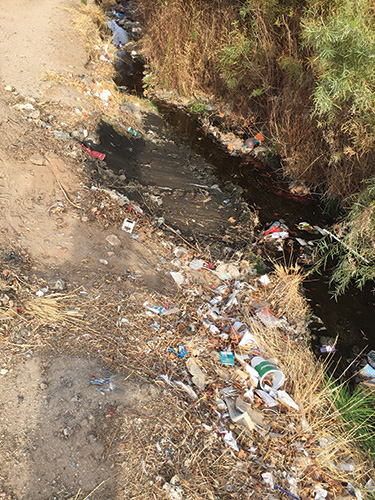Having trash receptacles in convenient locations will reduce improperly discarded items entering our waterways and eventually our oceans.
By Ken Beckstead
We all need clean water to survive. As our population increases, the amounts of various visible and non-visible pollutants entering our storm drain conveyances are alarming. We all live in watersheds, an area that drains to a specific place. The continental divide is a great example—any rain that hits west of the divide goes to the Pacific Ocean.
There are storm drains that, in most cases, drain unfiltered water to our streams, rivers, lakes, and eventually our oceans. Some storm drains are hooked to the sanitation systems of the municipality. Both have drawbacks. The combined systems can only take so much rainwater until the system has to release untreated rain and sewage into receiving waters. The separate system (MS4) can take large volumes of rain without ever impacting sewage flows, but all water in the storm drain systems is unfiltered.

Dealing with Trash Flow Challenges
Large visible pollutants like cans and bottles on streets are easily swept by street sweepers, but cigarette butts, rubber from tires, brake pad dust, oils, and greases can be hard to capture. When you have all these items in a creek, they are difficult, if not impossible to completely remove. Having trash receptacles in convenient locations will reduce improperly discarded items entering our waterways and eventually our oceans. Ocean plastic pollution is a concern for us all. As the microplastics get broken down into smaller pieces by tides and currents, they are inadvertently ingested by marine life and enter our food chain. Cigarette filters contain up to 16,000 individual plastic micro fibers. In 1998 alone America discarded 176,000,000 million pounds of cigarette waste. It is estimated that 80 percent of cigarettes are improperly discarded. This is a leading cause of ocean plastic pollution and is preventable with cup holder ashtrays and conveniently placed cigarette receptacles. There are many different designs of cigarette receptacles, some are open top and do nothing to prevent toxic compounds from leaching during rain and irrigation events. Some require sand, which must be mined, transported, then buried in a landfill once contaminated with cigarette waste. Cigarette receptacles should have secondary containment to prevent harmful non-visible contaminants from entering our waterways.
The Truckee River coming out of Lake Tahoe is a great example. Settlers used this watershed to resupply stocks and get their animals healthy after crossing Utah with 400 miles of alkaline water. This watershed was instrumental in the success of settling California, and the Nevada DOT installed cigarette receptacles in 2016 at each freeway rest area along the river to protect this watershed for future generations. The program has kept millions of micro plastic fibers from entering this historical watershed.

The Importance of Education
The duty of a storm water pollution prevention professional is to protect the Waters of America to the maximum practicable extent with the best available technology. Education is paramount, most people do not realize the impacts our daily lives have on our environment. Trash begets trash, having one cup or can on the ground will attract more and more trash very quickly. Our future generations will not survive with unusable water; it is our duty to protect our water today for someone else’s use tomorrow. Nobody wants to drink dirty water. Most people do not realize that cigarette butts are the number one littered item in the world. Education needs to start in schools where our future leaders can participate in community involvement. Once kids learn about the environment, they relate directly to their parents as the parents are putting trash in the recycling bin or flicking a cigarette butt out a car window. Once cigarette receptacles were installed at Caltrans rest areas, there was a 60 percent decrease in cigarette butts on the ground, saving labor costs to the state. The signage above each receptacle informed smokers that the cigarette waste could be used to generate much needed electricity for California.
Awareness on this subject will gain traction as our population increases, and the best time to act is now. Our planet and our future depend on it and deserves attention from all of us that call Earth home | WA.
Ken Beckstead was trained in storm water pollution prevention at the San Diego State Soils and Erosion Research Lab. Since then, he has invented the Butts Only Box® cigarette receptacle and the Gutter Critter, a storm water filtration device. Ken has earned awards from both the Senate and congress for his work protecting the Waters of America. He can be reached at [email protected].
